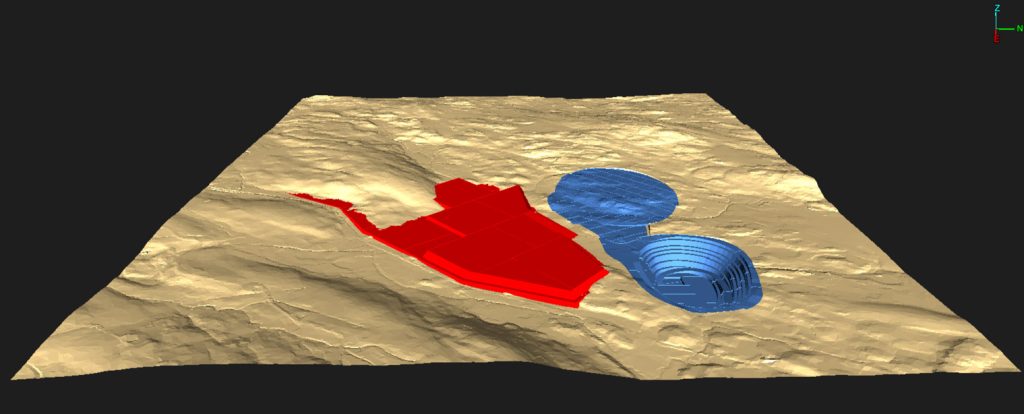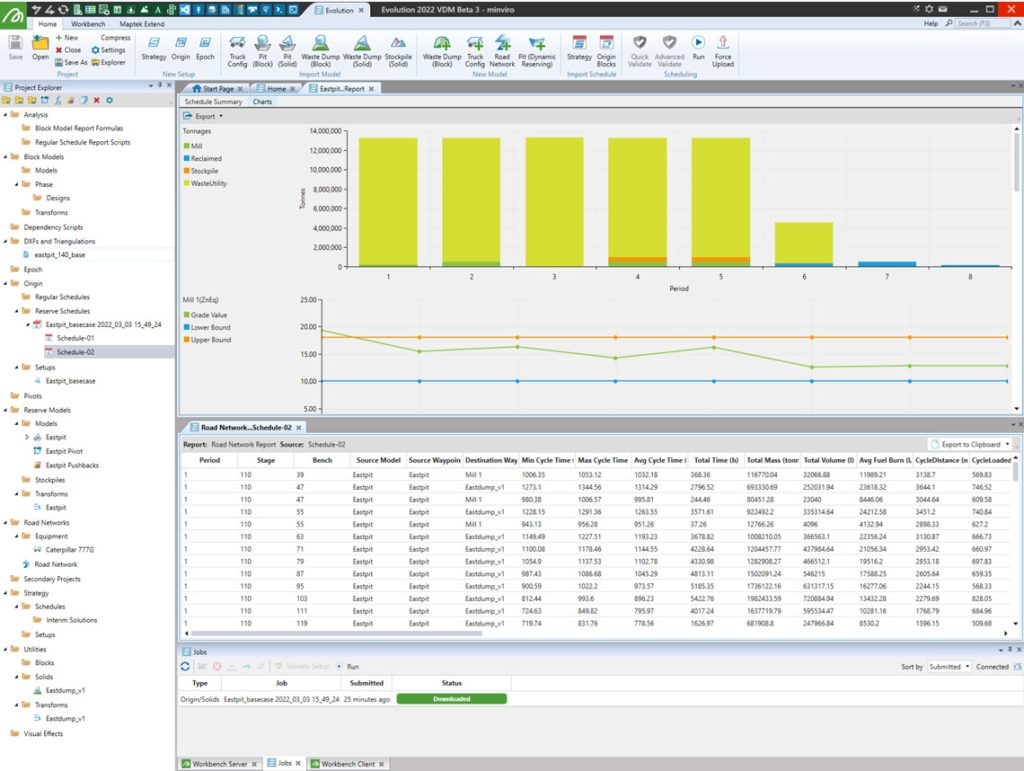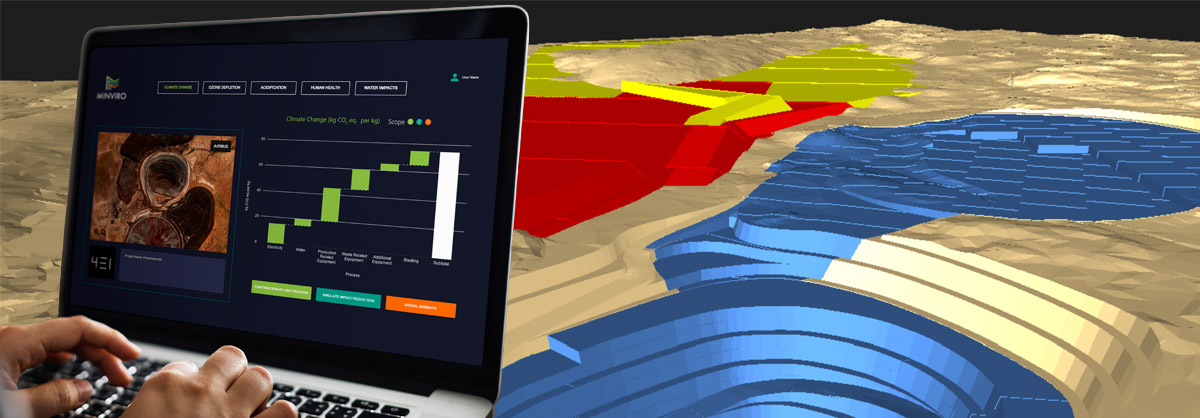March 2022 Issue Index
Environmental impacts of mining
Optimised scheduling combines with full life cycle analysis to quantify and reduce the environmental impacts of planned mines and monitor those in production.
Global demand for renewable and clean energy is increasing exponentially. Many green energy solutions are mineral intensive, and the transition to electric vehicles will require around 4 times more minerals than fossil fuel cars.
The mining industry is critical to the drive towards a low carbon global economy, and is central to the greening and decarbonisation of energy and transportation.
The International Energy Agency expects production of key minerals such as lithium and nickel to rise by more than 30 times by 2030 to meet demand. The mining industry is party to the growing need to apply data science, modelling and scenario planning to enable more agile decision making.
Technology collaboration
Maptek is well aware of the risks and challenges associated with mining and develops targeted solutions. Collaborating with other industry experts allows us to draw on a wider range of technological capability to develop targeted solutions to mining concerns.
Faced with the challenge of measuring, predicting and quantifying the environmental footprint of an operation, Maptek contacted Minviro, whose mission is to ensure that raw materials for the low-carbon economy are produced with minimal impact.
Maptek and Minviro have combined their technologies to enable mining companies to develop multiple optimised material movement scenarios, each of which can be run through an environmental impact life cycle analysis.
This process provides a solution to minimise an operation’s environmental impact while simultaneously optimising the material movement schedule.
Through his PhD project, Minviro Founder Dr Rob Pell recognised that, unlike other industries, the mining industry was rarely using life cycle analysis to understand its environmental impacts.
‘Too often, environmental impacts are assessed after the damage has been done. Minviro is providing the opportunity to consider life cycle analysis right from the planning stage,’ said Pell.
Minviro’s technology, MineLCA can be employed to predict a project’s environmental footprint as it develops, or it can be used in real time in a producing mine to monitor daily environmental performance. Developers can demonstrate the sustainability of their project to key stakeholders.
Operators can incorporate life cycle analysis into environmental, sustainability and corporate governance reporting around daily or weekly material and energy consumption and project impacts.
The challenge is to optimise mine planning, with its many, often conflicting constraints and objectives, together with environmental impacts.
This is where Maptek Evolution software comes in, targeting the competing factors to develop valid optimised schedules.
Evolution draws on powerful genetic algorithms and cloud computing. This combination increases the capacity of engineers to evaluate multiple scenarios and consider further downstream studies such as environmental life cycle analysis.
The process
A resource block model is generated in Maptek Vulcan from drillhole data and is used to delineate geological domains. Grade is estimated from mineral assay logs in the drillhole data.

The mining engineer incorporates data such as economic value and proposed destination into the blocks. Data from the resource block model is combined with Vulcan pit and dump designs, and haulage routes for scheduling.
Evolution software calculates the movement of the blocks from in-situ location to final destination waste dump, stockpile or crusher, incorporating all the vehicle usage, material movement, blast consumable usage and crusher feed parameters.
The engineer can experiment with different designs and haul routes, or alternative approaches to material movement, such as conveyors for some or all of the route.
Results are easily understood through graphically rich dashboards. Engineers can clearly visualise where material has come from and where it has been sent.
Every aspect of the mine planning and scheduling value chain refers back to the resource model data. Evolution can process multiple variables to deliver valid schedules along with on-the-fly haulage.
‘Evolution allows engineers to spend more time generating schedule alternatives, so downstream specialists can use the information to consider other performance metrics,’ said Maptek Mining Engineer Scott Britton.
Innovative approach
To test the innovative approach, real world mining data was modified to represent a generic open pit mining operation.
Britton generated several mine plan scenarios including extraction, haulage and waste dumping processes. The scenarios also test fundamental alternatives, such as the sequence with which the waste dump is formed along with alternative waste dump formation strategies that minimise above ground dumping of mine waste.

Other alternatives consider the impact of profiling waste dumps to their final rehabilitation shapes in order to minimise the disturbed ground footprint and reduce the double handling of materials, allowing stripped soils to be laid directly on prepared areas.
Engineers can consider a raft of scenarios, from alternative explosives for blasting, to fleet alternatives, to relatively minor adjustments to the dumping plan, and quantify the results.
Each scenario is optimised and the published schedule is passed to Minviro via Evolution’s schedule sharing API which enables integration to third party applications.
Once an Evolution schedule is generated, customers upload it to the cloud service, making it available for authenticated users to download.
The API provides all of the information from the schedule, enabling third parties to analyse the data. Each completed scenario is exported from Evolution to the API for consumption by Minviro’s MineLCA software.
The Minviro team undertakes a detailed life cycle analysis on each scenario, on a range of environmental impact categories, that can include global warming potential, acidification and water use. They can also inform the customer on strategies, new technologies and alternative approaches that can help reduce their overall environmental footprint.
Conclusions
Operations today are interested in a range of environmental impacts besides global warming and CO2.
‘Every project has different energy requirements, chemical use, fossil fuel consumption and water use, before region-specific factors like water scarcity or electricity grid mixes come into play,’ Pell said.
‘It’s not enough to limit impacts at the mine face alone – miners must consider their whole supply chain, with emphasis placed on the most sustainable sources.’
Minviro will continue to seek to quantify and reduce environmental impacts, and MineLCA is a powerful tool for looking at the entire mining process to identify hotspots.
Maptek sees its role in the future of mining as providing innovative technology to make data driven decisions enabling smarter mining. Giving our customers the power to process their data and seamlessly integrate with dynamic innovators like Minviro is a significant step in improving sustainability across the mining industry.
Thanks to
Minviro
- Maptek and Minviro investigate how best to combine their technology to minimise an operation’s environmental impact while simultaneously optimising the mining schedule
- Minviro solutions consider life cycle analysis right from the planning stage by predicting the environmental footprint of a project as it develops
- Evolution scheduling manages the competing factors to develop valid optimised schedules that enable downstream environmental life cycle analysis

